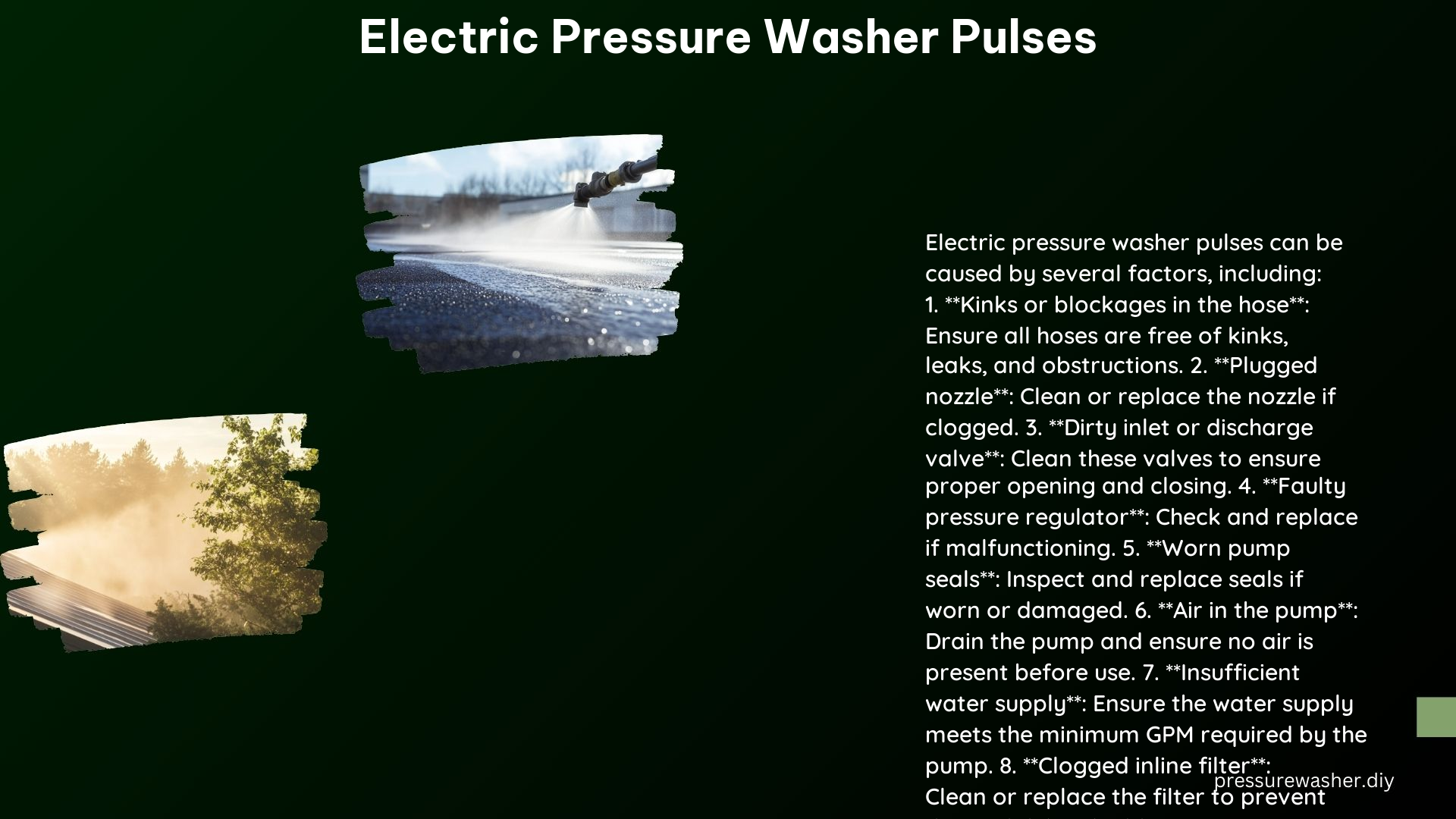Electric pressure washers are a powerful tool for cleaning a variety of surfaces, from driveways and patios to vehicles and outdoor furniture. However, these machines can sometimes exhibit a pulsing or surging behavior, which can disrupt the cleaning process and potentially damage the machine or the surfaces being cleaned. In this comprehensive guide, we will explore the causes of electric pressure washer pulsing, provide detailed troubleshooting steps, and offer preventive measures to ensure your pressure washer operates smoothly and efficiently.
Causes of Electric Pressure Washer Pulsing
-
Kinks and Blockages in Hoses: Ensure all hoses are free of kinks, leaks, and obstructions. Check that all hoses fit and are correctly connected. Kinks or blockages in the hoses can restrict the flow of water, leading to pulsing.
-
Plugged Nozzle: A clogged nozzle can cause the pressure washer to pulse. Clean or replace the nozzle if it is obstructed with debris, such as dirt, sand, or mineral deposits.
-
Dirty Inlet or Discharge Valve: The inlet and discharge valves in the pressure washer pump play a crucial role in regulating the water flow. If these valves are dirty or malfunctioning, they can cause pulsing.
-
Faulty Pressure Regulator: The pressure regulator is responsible for maintaining a consistent water pressure. If the regulator is damaged or not functioning correctly, it can lead to pulsing.
-
Worn Pump Seals: Over time, the seals in the pressure washer pump can become worn or damaged, causing water to leak and leading to pulsing.
-
Air in the Pump: Air trapped in the pressure washer pump can cause the water flow to pulse. To remove air, run water through the pump without the cleaning wand attached.
-
Insufficient Water Supply: If the water supply does not meet the minimum GPM (gallons per minute) required by the pressure washer pump, it can result in pulsing.
Troubleshooting Steps for Electric Pressure Washer Pulsing

-
Check Hoses and Connections: Inspect all hoses for kinks, leaks, and obstructions, and ensure that all connections are secure.
-
Clean or Replace the Nozzle: Use a thin metal wire or a nozzle cleaning kit to clear any debris from the nozzle. If the nozzle is severely clogged, replace it.
-
Clean the Inline Filter: If the pressure washer has an inline filter, clean or replace it if it is clogged with dirt and debris.
-
Inspect the Pump and Valves: Carefully examine the pressure washer pump and valves for any signs of wear or damage. Replace any worn or malfunctioning components.
-
Verify the Water Supply: Ensure that the water supply meets the minimum GPM required by the pressure washer pump. If the water supply is insufficient, consider using a larger diameter hose or increasing the water flow.
Preventive Measures for Electric Pressure Washer Pulsing
-
Flush the Hose and Pump After Each Use: Remove any residual dirt and debris from the hose and pump to prevent blockages and ensure smooth operation.
-
Use a Water Filter: Install a water filter to prevent dirt, debris, and mineral deposits from entering the pump and nozzle, which can lead to pulsing.
-
Keep the Pressure Washer Clean and Well-Maintained: Regularly clean the exterior of the pressure washer and check all components for wear and tear.
-
Store the Pressure Washer in a Dry Place: Protect the machine from moisture damage, which can affect the pump and other critical components.
Technical Specifications for Electric Pressure Washer Pulsing
-
Pressure Regulator: The pressure regulator is a crucial component that controls the water pressure to prevent surging or pulsing. It typically has a pressure range of 1,000 to 3,000 PSI and a flow rate of 1.2 to 2.5 GPM.
-
Pump Seals: The pump seals in an electric pressure washer are designed to withstand high pressures and prevent water from leaking out of the pump. They are typically made of materials like Viton or EPDM and have a lifespan of 50 to 200 hours of use.
-
Water Supply: The water supply for an electric pressure washer should meet the minimum GPM required by the pump, which is typically between 1.2 and 2.5 GPM. Using a water supply with insufficient flow can lead to pulsing.
DIY Fixes for Electric Pressure Washer Pulsing
-
Clean the Nozzle and Filters: Use a thin metal wire or a nozzle cleaning kit to remove any debris from the nozzle and inline filters.
-
Replace Worn Pump Seals: If the pump seals are worn or damaged, replace them to ensure consistent pressure and prevent pulsing.
-
Check and Adjust the Pressure Regulator: Ensure the pressure regulator is functioning correctly by checking for any signs of damage or wear. Adjust the regulator as needed to maintain a stable water pressure.
By following the detailed troubleshooting steps and preventive measures outlined in this guide, you can effectively diagnose and resolve pulsing issues with your electric pressure washer. Remember to always prioritize safety and consult the manufacturer’s instructions for specific maintenance and repair procedures.
Reference:
- https://www.bisongenerator.com/Blog/pressure-washer-surging-pulsing.html
- https://www.bisonindustry.com/news/pressure-washer-surging-pulsing/
- https://www.detailingworld.co.uk/threads/pulsing-pressure-washer.281290/
- https://www.myoleo-mac.com/int/green-ideas/why-my-high-pressure-washer-pulsing/
- https://www.reddit.com/r/fixit/comments/13e44k4/why_does_my_power_washer_pulse/
